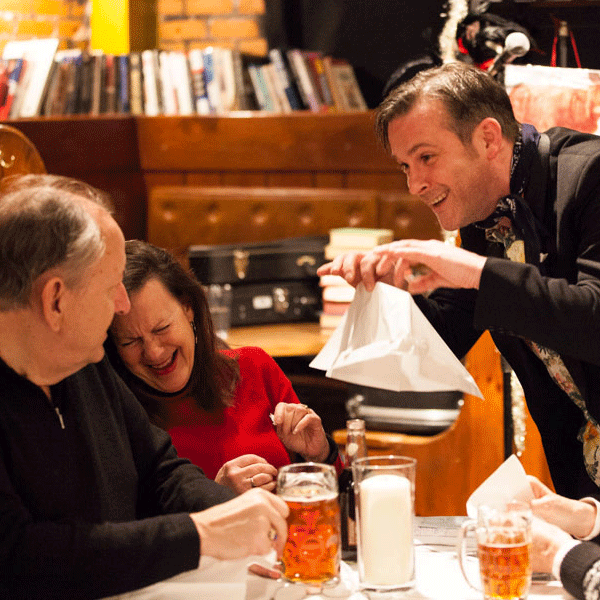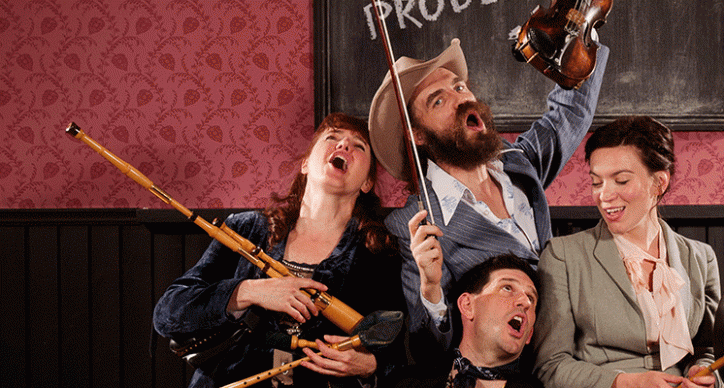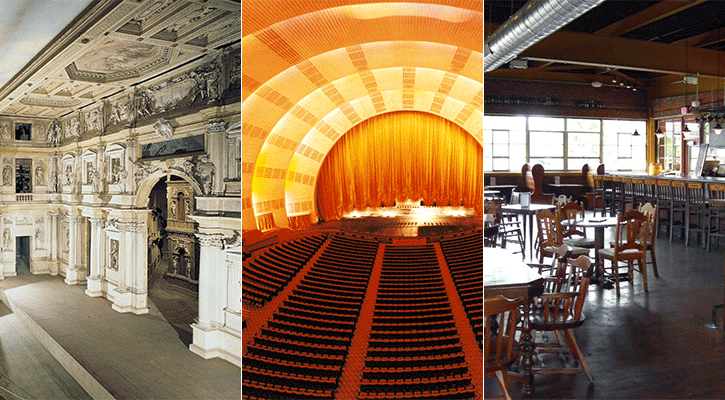Theater and brews last week during “The Strange Undoing of Prudencia Hart”

Photo by Mark Gjukich Photography.
Performer and audience members having fun and brews during last week’s The Strange Undoing of Prudencia Hart at Corner Brewery in Ypsilanti.
3 Questions for Director Wils Wilson
Editor’s note: This piece is a part of a series. You can also read Leslie Stainton’s essay on the power of place (or not) in theater.
Photo: Cast of The Strange Undoing of Prudencia Hart. Photo by Simon Murphy.
The Strange Undoing of Prudencia Hart is at Corner Brewery in Ypsilanti January 8-13. Our regular contributor Leslie Stainton interviewed the play’s director, National Theatre Scotland’s Wils Wilson.
Leslie Stainton: What happens to the theatrical experience when you move it into a pub (or other unconventional venue)? Does the audience change?
Wils Wilson: When the audience come into the venue for Prudencia Hart, there is a folk music session already going on. People are playing and singing, you can get a drink from the bar, you choose where to sit at small tables, and the performers come and talk to you in an informal way, asking you to do a simple task. So already the atmosphere is communal, convivial, playful and warm. We’re all in the same room together. It’s completely unlike the conventional theatre experience from the start, a different contract between audience and performers, one that allows space for a lot of intimacy, fun and emotional engagement.
A different space always brings with it a different audience. You get a conventional theatre audience, and you also get people who are intrigued to see how their bar or community hall will be used. There’s a sense of event, which has an appeal to a wide variety of people, so you often get a very mixed audience which is a huge advantage.
LS: How do Robert Burns, Border Ballads, and the poems of Robert Service speak to a global audience in the 21stcentury?
WW: David [David Grieg, creator of Prudencia] and I were attracted to the Border Ballads because they are fantastically dramatic stories of love, death, passion and the supernatural. They deal with such fundamental emotions and ideas they feel timeless. Robert Service’s wrote hugely popular tales of bold deeds in energetic rhyming verse again dealing with love, betrayal – big universal themes. It’s interesting, having played Prudencia now in a number of countries, that the idea of a folk tradition with stories of the devil and a borderland between this world and another, seems to be recognized wherever we go. The truth is that when you make a new piece, you just have to make something which feels necessary and relevant to you and which you yourself are truly interested in and challenged by – and if you make it well enough, it will speak to people wherever you go.
LS: Technology is increasingly defining our world. Where does live theater fit into this? How can theater help redress the imbalance we now seem in danger of experiencing?
WW: People will always be hungry for live theatre, music, dance, events. Nothing in the virtual world will ever replace seeing a real performer in front of you, seeing and feeling their emotion, seeing the sweat on their forehead.
So I think theatre should feel very confident just now, both in its own unique power and in how it engages with technological innovation. The two worlds don’t have to be seen in opposition. They will both continue to exist alongside each other, serving different needs.
The Power (or Not) of Place
Editor’s note: The National Theatre of Scotland performs A Christmas Carol on December 17 – January 3, 2016. The performance take place in an unconventional space: inside a box on the stage of the theater.
In my early twenties, I joined a children’s theater company and for half a year toured southeastern Pennsylvania putting on plays in elementary schools. I’d done my share of theater elsewhere, but nothing approached the energy of those performances. Every day we’d troupe off to another school to give our show and do a workshop. I’d been told children were the most demanding of audiences, but I never felt less than welcome anywhere we went, maybe because most kids were giddy with pleasure at the arrival of a bunch of costumed adults in their midst. (I played a dog.) It’s one thing to go to the theater, another to have it erupt in your cafeteria on a rainy weekday morning, much the way medieval pageants used to erupt in town squares.
We had little scenery and one change of clothes. I suspect we weren’t far from the kind of enterprise Peter Brook had in mind when he said the only thing needed for an act of theater to take place is for one person to walk across an empty space while someone else watches. The kids who sat cross-legged on carpet squares watching us perform certainly didn’t seem to distinguish between what we were doing and what took place downtown in the fancy 19th-century opera house our troupe called home—the kind of building Brook had in mind when he said of the theater: “Red curtains, spotlights, blank verse, laughter, darkness, these are all confusedly superimposed in a messy image covered by one all-purpose word.”
Photo (L to R): Palladio’s Olimpico, Radio City Music Hall, the Corner Brewery.
God knows the human thirst for stories has led to some amazing spaces: the ancient Greek amphitheaters with their literal sky, Palladio’s ornate Olimpico with its figurative one, Shakespeare’s Globe, the Sydney Opera House, Radio City Music Hall. But as pieces like Prudencia Hart remind us, it doesn’t much matter where plays are performed—or maybe it does matter, just not in ways we’ve been taught to expect. “Space that has been seized upon by the imagination,” writes Gaston Bachelard, “cannot remain indifferent space subject to the measures and estimates of the surveyor.” Performance transforms the sites we inhabit. I’ve often wondered if those elementary-school kids thought differently about their surroundings after we’d left. I hope so. Surely Ypsi’s Corner Brewery will be changed, perhaps in lasting ways, by what takes place inside it this January 8-13.
In a 2010 TED talk, Ben Cameron of the Doris Duke Foundation suggested that many purpose-built arts venues “were designed to ossify the ideal relationship between the artist and audience most appropriate to the 19th century.” Cameron and others argue that unless performing arts organizations rupture traditional thinking about arts settings, the whole culture of performance will stagnate.
It strikes me that what’s happening in the performing arts—where conventional performance venues are increasingly yielding to breweries, planetariums, armories, rivers (our own Huron!), and the local multiplex (witness the global appeal of the Met’s live broadcasts)—is not unlike what’s happening in the world of print publishing. Where either will end up is anyone’s guess, but we’re clearly changing the way we communicate—and with whom. When the Boston Lyric Opera presented two free outdoor performances of Carmen in 2002, more than 100,000 people showed up. A third of them were seeing an opera for the first time.
The National Theatre of Scotland proudly states on its website that it has “no building,” and therefore has “no bricks-and-mortar institutionalism to counter, nor the security of a permanent home in which to develop. All our money and energy can be spent on creating the work”—which they perform in places as varied as car parks, forests, Edinburgh’s Royal Lyceum, and Ypsi’s Corner Brewery.
Back when I toured with the kids’ theater troupe, we had no box office, no lobby, no lights, no stagehands, no drops descending from on high, no tickets or sound system or props— just ourselves and what we could carry in the back of a station wagon. Our audiences didn’t care. Maybe some of it had to do with their age. But I’m sure it also had to do with the enduring power of make-believe, the freedom that actors represent, and the startling discoveries that can happen when a familiar space is made new, and the audience with it.




